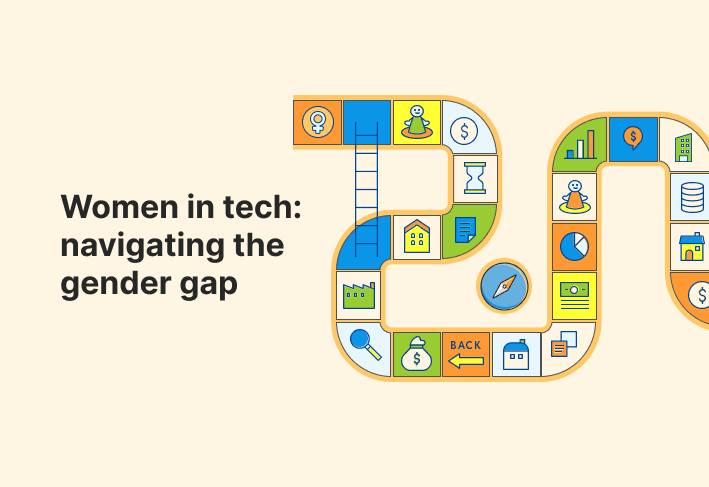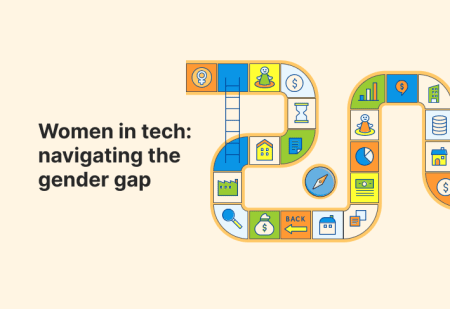Technology may have advanced, but the gender gap in tech remains. Across the tech industry, the attrition rate for women is 45 percent higher than it is for men — and 50% leave their roles by the time they’re 35.
Companies can (and should) do more to support women in tech by proactively calling out and dismantling systemic biases. We’ll break down the career-altering challenges that so many women and gender minorities face, and we’ll offer some useful strategies for those who must navigate them daily.
In this article, we use the term women inclusively to refer to all women, regardless of their assigned gender at birth — including nonbinary, gender nonconforming, genderfluid, and other non-cisgender individuals who also face systemic gender inequality and suffer from unfair workplace policies and practices.
1. The likability paradox
In many societies, traditional gender norms prescribe that the ideal woman is kind, conciliatory, and nonassertive. Women who don’t conform to these standards are seen as less likable, but those who do are less likely to command respect from their peers. Ridiculous, you might say — and we agree! But the likability paradox persists.
So how does the likability paradox play out at the workplace? Women frequently walk a tightrope between managing unspoken expectations based on deeply rooted biases and simply getting the job done. This paradox is even more apparent for women in leadership roles or positions of power. For instance, a Columbia Business School experiment showed how perceptions of the exact same behavior varied depending on whether the successful businessperson was a man or a woman.
“The same characteristics are labeled differently in men and women, especially at the leadership level. If a woman is hard-nosed or asserts her view, she could be called aggressive, irrational, or even crazy. I’ve seen how men can yell in frustration and no one blinks an eye. But if women react, they’re immediately discredited. Over the years, I’ve learned to keep a straight face and never appear ‘emotional.’” – Tara Sinquefield, content engineer and former IT manager (she/her)
2. The performance tax
A Stanford Business School study of performance reviews found that there is inherent bias when supervisors evaluate individual employees. And the bias in favor of men is stronger in male-dominated jobs such as those that involve leadership or technical skills.
Women are also subjected to gender policing and are not rewarded even when they possess the same traits that are highly valued in men. Compared to men in the same roles, women are held to higher standards and more readily penalized over any gaps in their technical skills. And here’s the kicker: One survey found that almost 90% of women face backlash even when they do succeed at work.
When companies overlook women’s leadership potential, they make it harder for women to progress in their careers. Across the tech industry, women hold just 24% of leadership positions. This imbalance starts at the very bottom of the corporate leadership ladder — at the proverbial broken rung, where companies promote fewer women in entry-level positions to first-level managers. According to McKinsey, this is why women only hold 40% of manager-level positions in a typical company, and the number decreases as they go higher.
3. The gender pay gap
Recent research found that women are offered 3.5% less pay than men for the same tech role in the same organization. While that doesn’t sound like much, the gender pay gap is likely to increase over time because of the barriers to progression (and better pay) that women continually experience in the workplace. (Fair pay is also a matter of principle and not just math.)
In Europe, women in tech make 26% less than men. And in the U.S., a quick search on Zippia showed that the average sysadmin salary for women is 5% lower than it is for men. That’s not cool.
4. Intersectional gender inequity
For women of color and LGBTQ+ individuals, overlapping social identities can make the disparities and challenges even greater. For instance, women of color in tech report experiencing higher levels of bias at work than white women. Many face gender, racial, and ethnic stereotyping; unfair job expectations; and the need to work harder to prove themselves.
According to McKinsey, despite more Black, Latina, and Native American women holding tech degrees, their share of tech jobs dropped by more than 10% between 2016 and 2021. Black and Hispanic women in tech also earn some of the lowest wages in the industry.
Useful data on LGBTQ+ tech workers is nonexistent as they are often excluded from measurement. But early research suggests that systemic inequalities exist and can impact their career opportunities, perceived professional credibility, and the ability to fit in at work. In the U.S., 23% of LGBTQI+ employees surveyed experience discrimination at the workplace. That’s 23% too many.
“All inequality is not created equal.” — Professor Kimberlé Crenshaw, civil rights advocate and Professor of Law, UCLA and Columbia Law School, who coined the term intersectionality
5. The motherhood penalty
The motherhood penalty is the price that working women pay for choosing or planning to have kids, such as decreasing income over time. One study estimates that female breadwinners face a 60% drop in their prechildbirth salaries compared to their male partners. After having children, women are also less likely than men to switch to a higher paying job and more likely to stop work altogether.
Working mothers also face a higher risk of negative stereotyping and gender bias. Compared to working fathers, working mothers are more likely seen by employers as less committed or less competent at work — even though research shows otherwise. Perceptions and policies rooted in gender bias can impact everything from their wages to their chances of getting hired or promoted.
In the U.S., unlike many other countries, there’s no federal law that requires U.S. companies to provide paid maternity leave. And those who do are still a minority. Only 40% of employers provide paid maternity leave to their employees.
In many industries, women experience unequal standards and career hurdles in ways that men do not. And, despite advances in the field, tech companies are no exception. By calling out these widespread gender gaps, we’re advocating for much-needed change and greater gender equality for women across the industry. Until these issues are addressed, tech companies will continue to struggle to attract and retain women — and some of the best talent out there.
How can women in tech navigate gender inequality?
To be clear, it’s not the job of women and gender minorities to eliminate systemic gender inequality and discrimination. But according to the World Economic Forum, it will take more than 130 years for the gender gap across the world to close — and that’s a long time to wait. In the meantime, here are a few ways that women in tech can navigate the gender gap, advocate for themselves, and thrive.
Find good mentors
Mentors play a key role in a person’s professional growth and success, whether you’re fresh out of school or halfway through your career. In an internal panel discussion organized by PDQ, three women business leaders offered some valuable insights and advice on finding mentors who can help you.
Reach out actively and choose people with roles and experiences that you’re interested in.
Be clear and specific about what you’re asking for help with.
Choose different mentors for different skills you want to learn.
Remember that mentorship doesn’t have to be a long and formal process. It could even be a single conversation.
“I had a great mentor and role model in school. There were only two female students in my entire class and this teacher would regularly push us to step out of our comfort zone. She was tough, but fair and very encouraging. She was really invested in our growth and wanted us to take the lead in getting more attention for the computer science program. We ended up having a lot of fun and I learned a lot from her.” – Kaela Tudhope, software engineer (she/her)
Build a strong support system
Form relationships with people who show up for you, celebrate your wins, and defend your right to be heard and acknowledged for your work. At a community level, consider joining groups that you identify with. These can be within your company or external organizations that focus on providing communal support, resources, and opportunities to women, women of color, and LGBTQ+ folks in tech.
Screen potential employers
When applying for jobs, try finding out how potential employers support women and gender minorities. For example, does the tech company offer paid parental leave and childcare benefits? Employee resource groups (ERGs) for women, people of color, and LGBTQ+ folks? Mentorship programs?
Besides scouring the company website, consider checking out job review sites or third-party resources. You could also ask an existing employee (if you know one) or ask during the interview itself (HR practitioners suggest waiting till the second round of interviews). Most importantly, know your rights so that you know when you’re being unfairly treated.
Focus on what you can do instead of what you can’t
Gender discrimination is all too common, and sometimes women can internalize the struggles they face. (Facing double standards and being underestimated will do that to a person.) Imposter syndrome may be a popular term, but remind yourself that it’s seldom a reflection of your true abilities (and might actually result from gender discrimination). To overcome self-doubt or discouragement, try adopting a growth mindset and focus on the things you can do to build your knowledge and confidence at work.
“Tech is a space that anyone can enter as long they have the necessary skills and knowledge — even if they don’t have formal degrees. There are senior engineers on my team who are self-taught. It’s totally plausible. At PDQ, we work with Tech-Moms to teach people to program and make websites. And they can use what they learn to make a living, which is neat and really empowering.” – Taylor Pine, programmer and software engineer (they/them)
Cultivate your superpower
In the same panel discussion, the speakers shared how they had, in the face of gendered discrimination, discovered their own personal superpowers and used them to succeed at work. For some women, being relentless in pursuing their goals is their superpower. For others, it’s staying focused and intentional in everything they do. Your superpower can be anything that equips you to overcome difficulties and achieve success.
For example, it could be mastering the art of negotiation, developing the critical elements of emotional intelligence, or just being friggin’ good at your job. The important thing is to nurture what gives you the ability and strength to rise above and keep going.
“Ultimately, if someone in a nonleadership role doesn’t feel comfortable speaking up for whatever reason, it doesn’t make them a bad person. We don’t have to fight every battle or fight them right away. It’s okay to pace ourselves and do it when we’re ready. And it shouldn’t be on women alone to do all the work all the time. It’s okay to take a break and choose rest instead.” – Gaia Beatrice, staff software engineer (she/her)
At PDQ, we’re fortunate to have leaders and coworkers who support gender diversity and work hard to create a safe, inclusive, and equitable workplace for all — especially women and LGBTQ+ employees. Sounds idealistic? Maybe. And we know that there’s room for improvement. But we’re problem solvers at heart who love a good challenge, especially if it aims to make life for folks a little easier to bear. If this sounds like the place for you, come join us! Or follow the PDQ blog for more news and good reads.





